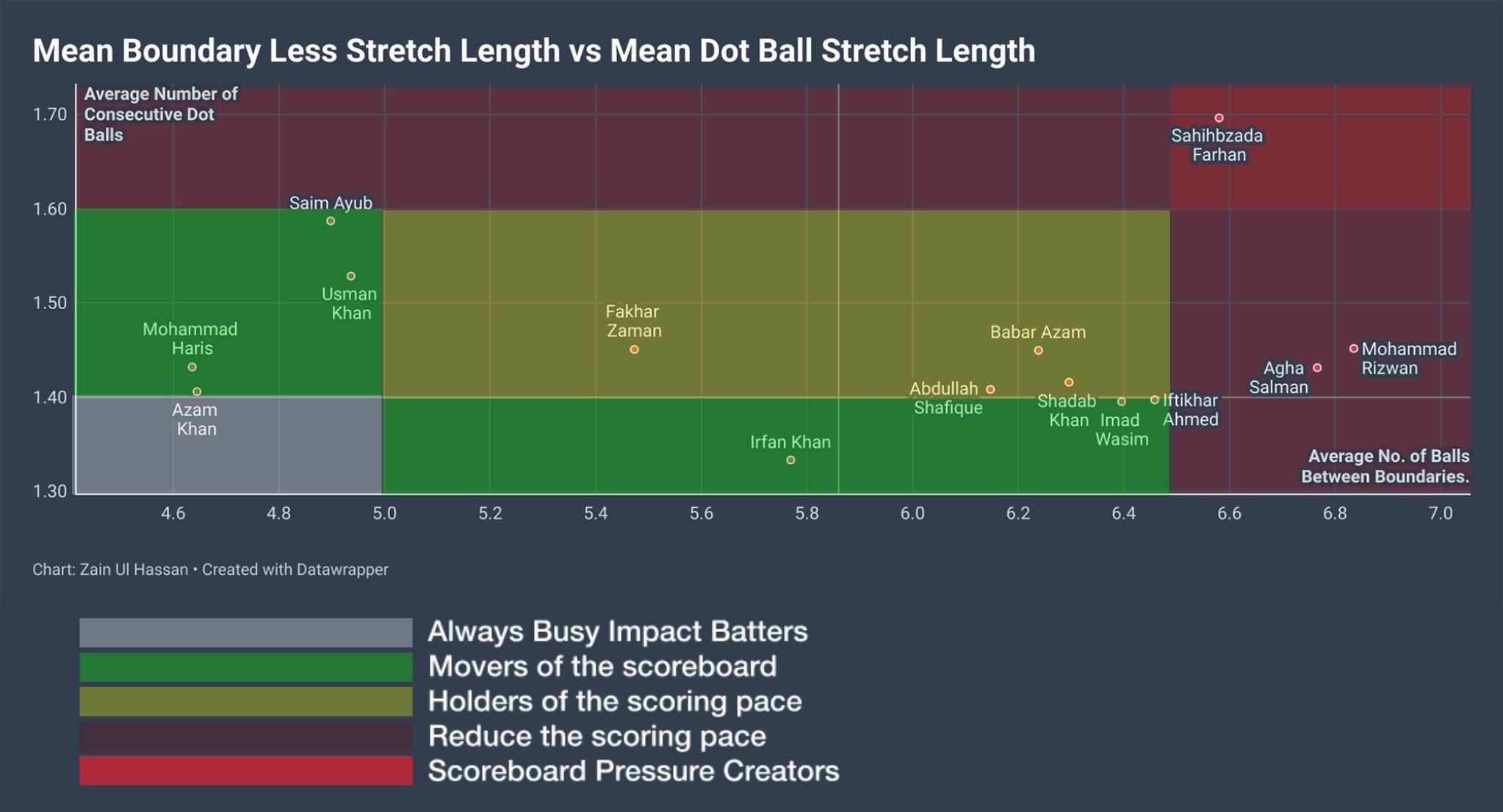
Unveiling the Batting Dynamics of Pakistan’s 2024 T20 World Cup Core Group
The cricketing world gears up for the highly anticipated T20 World Cup 2024, and the spotlight is again on the batting prowess of players representing their nations on the grand stage. In the era of modern cricket, where data analytics plays a crucial role in decision-making, we will analyze the statistics deeply to uncover the batting dynamics of key players for the upcoming tournament.
Understanding the metrics:
We begin our analysis by focusing on two key metrics that shed light on a batsman’s ability to keep the scoreboard ticking.
- The Average Number of Consecutive Dot Balls
- The Average Number of Balls Between Boundaries.
Average Number of Consecutive Dot Balls:
This metric signifies a batsman’s proficiency in avoiding consecutive dot balls, which can mount pressure and lead to dismissals. Lower values of this metric indicate better performance in keeping the scoreboard moving.
Average Number of Balls Between Boundaries:
This metric reflects a batsman’s capability to find boundaries consistently, a crucial aspect in maintaining a high scoring rate. Again, lower values of this metric are desirable, as they indicate a batsman’s ability to score boundaries frequently.
Categorizing Players:
Based on our analysis of the provided data from ESPNCricinfo, we categorize the players into five distinct categories, each representing a unique batting style and impact on the game. If we plot a graph between the two metrics we have devised, we can easily see the distribution of players in the whole graph and determine what particular player falls in which category in the graph. Apart from players’ numbers, there are two lines at x = 1.40 and y = 5.85, which is the average of our values.
Really Busy Impact Batters:
Azam Khan: Among the players analyzed, Azam Khan stands out as a busy impact batter, showcasing the ability to rotate the strike efficiently and maintain a high scoring rate.
Movers of the Scoreboard:
Irfan Khan, Imad Wasim, Iftikhar Ahmed: These players exhibit a knack for keeping the scoreboard moving with boundaries at regular intervals, averaging a boundary every 6.5 balls or fewer, and playing consecutive dot deliveries less frequently (average below 1.4).
Usman Khan, Saim Ayub, Mohammad Haris: These players excel in scoring boundaries frequently, averaging a boundary every five balls while minimizing the number of consecutive dot deliveries.
Holders of Scoring Pace:
Babar Azam, Abdullah Shafique, Fakhar Zaman, Shadab Khan: This category comprises players who maintain the scoring pace by consistently finding boundaries (average boundary every 6.2 balls) while also keeping the number of consecutive dot deliveries low (average below 1.5).
Scoring Pace Reducers:
Mohammad Rizwan, Agha Salman: Players in this category exhibit a slightly slower scoring pace, with boundaries coming later (average boundary after every 6.5 balls).
Scoreboard Pressure Creators:
Sahibzada Farhan: Finally, Sahibzada Farhan falls into the category of scoreboard pressure creators, hitting boundaries less frequently (average boundary after every 6.5 balls) and playing around 1.7 consecutive dot balls on average.
Conclusion
As teams finalize their squads for the T20 World Cup 2024, this analysis provides useful insights into the batting dynamics of key players. By understanding each player’s strengths and contributions to the team’s scoring rate, Pakistan can assemble a well-balanced and competitive squad capable of achieving success on the global stage.
With data-driven strategies at the forefront, teams can harness the power of analytics to optimize their batting lineup and maximize their chances of lifting the coveted trophy in the upcoming tournament. As far as Pakistan is concerned, Azam Khan’s inclusion is justified on its own, being the most prolific batter and the closest to perfection in the entire squad among those who attended the Kakul training camp. Haris closely follows him and has some good numbers as well, but is out of contention.
Saim upfront with Babar can play a significant role in delivering quick starts, and Usman in the middle order can be handy. Rizwan’s performance over the years may be a cause for concern because his style suggests he tends to put pressure on the other batters. The non-selections of Agha and Farhan appear to be good calls based on this analysis.
The opinions expressed solely belong to the writer and do not necessarily reflect the views of Grassroots Cricket.








Leave a Reply